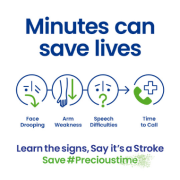ESO Department to Department Visit at Vall d’Hebron University Hospital Stroke Unit
European Stroke Organisation Department to Department Visit Program 2018- Visit Report
Awardee: Mariana Dias
Period of the visit: 1 January 2019 – 28 June 2019
During my 6 months stay at Vall d’Hebron University Hospital Stroke Unit I had the opportunity to experience and learn different areas and technics. I have spent 1 month on the Stroke Unit, 1 month on Neurossonology, 2 months on Stroke Echoscopy, 1 month with the Stroke Code team on emergency department and 1 month doing scientific research.
During the period on the Stroke Unit I participated on the daily ward rounds and I had the opportunity to participate in the clinical discussions about the patients under the supervision of Dr. Marta Rubiera. This Stroke Unit has nine monitored beds, eight of them with 72-hour telemetry, with one stroke nurse dedicated for two patients.
During the Neurossonology rotation I had the opportunity to improve the technique of carotid and vertebral artery Doppler and transcranial Doppler. With the supervision of Dr. David Rodríguez-Luna and Dr. Noelia Rodriguez Villatoro I performed about ten exams every day that were always discussed and integrated with the patient’s clinical history. I also had the opportunity to learn how to monitor carotid or vertebral artery stent stenosis, to detect right-to-left shunt with transcranial Doppler and to interpret contrast enhanced carotid Doppler to study unstable atherosclerotic plaques.
For the two months that I have stayed on Stroke Echoscan I learned how to perform this technique and the advantages to have Neurologists with experience in this area. This technique is specially directed to detect potential stroke causes such as akinetic left ventricular segment, mitral valve stenosis and aortic arch atherosclerosis. With the supervision of Dr. Jorge Pagola and Dr. Jesus Juega I performed 66 exams to the patients admitted on the Stroke Unit and I had the opportunity to do a 3-days course of basic echocardiography with accreditation from the Spanish Cardiology Society. The Echoscan team is also in charge of the extended cardiac monitoring with wearable devices and I had the opportunity to see the advantages and limitations of these devices.
For the month that I have joined the Stroke Code team I had the opportunity to learn strategies to improve the hyperacute phase care. I have participated on the decisions regarding the patient diagnosis and treatment and observed the endovascular treatment on the angio-suite. I really appreciated the chance to observe the inclusion of patients on acute phase trials such as TASTE, TEMPO and THALES. I was also inspired by the workflow improvement strategies conducted at this center for example the direct transfer to angio-suite stroke code.
For the scientific research period I had the opportunity to work with colleagues from different countries with the orientation of Dr. Carlos Molina, Dr. Marc Ribó and Dra. Marta Rubiera. Our research was focused on the subject arterial blood pressure and thrombectomy and we are still collaborating in order to publish our findings. I also had the chance to work with two engineers doing their master in 3d printed thrombectomy models for endovascular treatment training.
During all the stay I also had the opportunity to attend the multidisciplinary meetings with the radiology, department scientific meetings and Catalunya Stroke Units meetings. I also had the privilege to be invited to the presentation of the thesis of Dr. Noelia Rodríguez Villatoro regarding the treatment options of hyperacute treatment of extracranial internal carotid artery tandem lesions.
I am truly grateful to professor Carlos Molina, Dr. Marc Ribó, Dr. Marta Rubiera and all the Stroke Unit Team for all the knowledge and opportunities that were given to me during these six months. I had the chance to be inspired by a team of Neurologists with challenging ideas that contributed to my formation as a Neurologist.
Finally, I am grateful for the support of the ESO for granting me this amazing opportunity.
Are you eligible for a Department to Department Visit?
You can apply if you meet the below qualifications. The application deadline is 28 February but we encourage potential applicants to be proactive about setting up a potential visit prior to the deadline.
Physicians or researchers born in 1980 or after – with an interest in the field of stroke. Applicants must be ESO members (Junior membership application is available here). In the selection process, we have a special emphasis on applicants from European low-middle income countries, interested in improving the stroke pathways and care in their institutions and six grants per year are reserved for this purpose.
More information: https://eso-stroke.org/eso-department-department-visit-programme/




